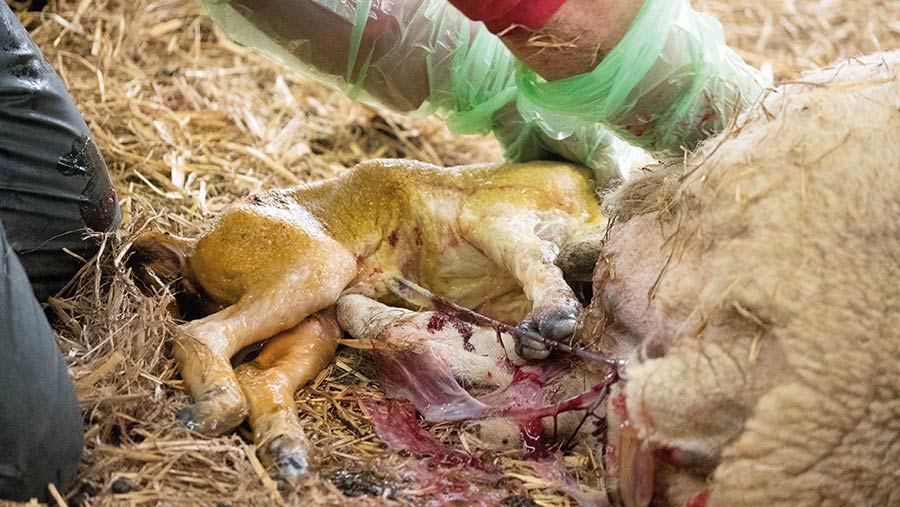Expert advice on assessing and managing lambing difficulties
 © Tim Scrivener
© Tim Scrivener With many flocks rapidly approaching lambing, now is a good time to prepare for potential issues. Specialist sheep vet Emily Gascoigne offers advice.
Assisting ewes in difficulty can be both stressful and rewarding. Getting involved unnecessarily can potentially lead to new problems.
Standard operating procedures that are easy to understand and communicated to the whole team – including students helping at lambing – can ensure a consistent approach.
See also: How to get the best from your vet student at lambing
Monitoring progress
A normal lambing (from water bag appearing to lambing completion) can take two hours. When observing, the key thing to look for is progress.
Warning signs for examination include:
- Unrewarding heaving
- A gap of more than 30 minutes between scanned lambs
- Signs of “having finished lambing” without delivery, such as eating while lambing
- Lack of heaving.
Intervention
Gloves should always be worn when examining ewes. Bacteria which cause joint ill in lambs have been identified in the vaginal discharges of ewes, so wearing gloves will reduce the chance of transferring bacteria across the flock.
Most malpresentations should be able to be corrected relatively quickly (see panel). As a guide, progress should have been made within 10 minutes.
Clean lambing ropes, lubricants (especially powdered), and head snares are essential tools in my lambing tool kit.
6 tips for correcting common malpresentations
- You can never have too much lubricant, so keep plenty to hand. Powdered lubricants are useful for outside lambing, too – especially if there is limited space in your tool kit
- Legs back: Legs back: remember your anatomy and work with what you have. Legs are attached to shoulders; shoulders are attached to the neck; the neck is attached to the other shoulder and so on. A well-placed fine lambing rope can help avoid the risk of losing the first leg.
- Head back: using the above principle, it is in there somewhere. The use of snares can be helpful to ensure ease of guiding the head into the pelvis once identified.
- Backwards presentation: once the back legs are accessed, a nice downward slope towards the ewe’s hind feet maximises ease of delivery. Lamb resuscitators may be especially helpful in these cases, where risk of inhalation of birth fluid is high.
- Tangled twins: pick the lamb with the head most forward. You may need to push the second lamb back slightly to access the first lamb fully.
- Where lambing assistance is needed, it is prudent to check for additional lambs, via examination with a gloved hand or by gentle external palpation. While restraining a ewe, it is also an excellent time to check for milk in both halves of the udder.
Colostrum
Any lambing intervention places the newborn lambs at a disadvantage.
Lambs requiring assistance have been shown to be slower to stand and suck colostrum. This means they should be a priority for colostrum feeding (whether they are born indoors or outdoors).
Lambs with swollen heads after a head-only lambing correction are perhaps a clear example of why feeding colostrum may be needed. But it applies to other corrections, too.
Remember, colostrum is gold – aim for 100ml for each kg of lamb in the first six hours. Typically, this amounts to 400ml, given over multiple feeds.
It is also prudent to check the ewe’s wellbeing during this time. Immediately after delivery she needs to “get back to work”, to mother and feed one lamb or more.
The pre-lambing health visit from your vet is an opportunity to review the pain management protocol for your flock health plan.
Caesarean section
A worthwhile discussion prior to the start of lambing is deciding on your flock-level policy on caesarean sections (C-sections).
With the strength of the ewe and lamb trade, the economics of performing a C-section on a ewe may be easier to compute than other years.
While the cost of a C-section will vary between practice, the greatest determinant of its economic success is the number of saleable lives at the end of the procedure.
And the greatest determinant of that – as demonstrated in recent published work – is the time between onset of lambing and surgery.
Delaying the decision to call for help – having one more go, putting the unborn lamb under further traction and stress – will all reduce the chances of success for ewe and lambs.
If a live litter and a live ewe negate the cost of the surgery, prompt decision-making and making the call to the vet will be the biggest driver of success.
Success rates of ewes with dead lambs, discharges and those that are unwell are likely to lead to poor outcomes. Euthanasia may be more appropriate in these cases.
Culling
Methods of recording assistance levels will vary between flocks.
While some flocks may be using electronic identification, cull tags are easy to use and more robust than spray marks to record ewes that need to leave the flock.
Mismothering, neglectful ewes or those requiring assistance may be selected against, especially in an extensive system.
A simple chalkboard showing the number of ewes assisted may be helpful for reviewing the degree of intervention needed.
If the number is high, perhaps ram choice and ewe health/condition need to be reviewed.
Lambing is the “best and worst of times”. Clear protocols for the team, investing time in student training and determining a clear intervention policy are prudent prior to the onset of lambing. Remember, #everylambcounts.

